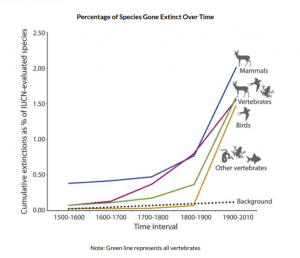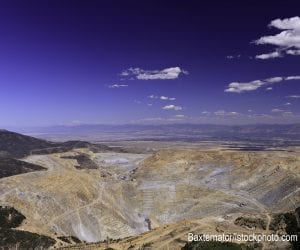Earth Day is next week, April 22nd. PopEd wants to help you make the most out of this teachable moment by providing lesson plans that use relevant, real-world data while also emphasizing important environmental themes.
Data is an effective avenue for exploring a range of environmental issues, from climate change to habitat health to water use. The use of real-world data brings these issues to life, making abstract concepts more tangible and encouraging students to develop deep connections and thorough understandings. Not to mention that the use of data encourages critical thinking and analysis skills, both of which are emphasized in the NGSS and Common Core standards. So don’t miss out – these real-world data lessons are sure to be new favorites in your Earth Day resource library.
Three lesson plans for Earth Day that use real-world data
1. The Sixth Extinction
In this high school biodiversity lesson, students analyze written articles, graphics, and numeric data to compare modern rates of extinction to background rates. It’s a great activity for APES!

The data connection: The numbers about extinction rates can be dizzying, but when students do their own calculations, they become more accessible and memorable. Viewing the data in visual format through charts and graphs allows for quick yet striking comparisons.
Why use it on Earth Day? This year’s Earth Day theme is “Protect Our Species.” Scientists assert that we are now in the middle of a Sixth Mass Extinction because of human activities. The observed extinction rate is between 1,000 and 10,000 times the background rate with as much as 50 percent of all species headed toward extinction by 2050. Humans are irrevocably damaging the delicate web of life that we so critically depend on, and awareness plays a key role in species protection.
2. Waste A- Weigh
This elementary level lab activity has students collect their own data on both individual and whole-class lunchtime waste. By weighing their waste every day for a week while implementing new waste-reduction habits like reusable containers and non-plastic utensils, students see how a change in behavior can have an immediate positive impact.
The data connection: What’s more real-world than collecting data about your own life? When students collect their own stats, they not only get practice with data collection and recording methods, but also become engaged in authentic learning and problem solving.
Why use it on Earth Day? According to the EPA, the average American generates almost 4.5 pounds of trash per day. While about one-third of that gets recycled, the rest ends up in landfills where it can leak toxic chemicals into the surrounding soil or water supply. Reducing waste is the most effective way to combat our outsized waste footprint.
3. Meat of the Matter
In this hands-on middle school lesson, students graph global meat consumption, use manipulatives to explore the environmental impact of four different types of protein, and discuss the pros and cons of a shifting global diet.
The data connection: Sometimes looking at data in a new format is key to understanding it. In this lesson, students use a grid and colored bingo chips to display data on various proteins’ impacts on water, land, and the atmosphere. This lesson is a great entry point for discussing the pros and cons of various types of data illustrations.
Why use it on Earth Day? Meat production is an incredibly resource-intensive process. It takes approximately 1800 gallons of water to produce 1 pound of beef and 33 percent of all cropland is used to farm grains, fruits and vegetables for livestock. Decreasing consumption of animal-based foods can have a significant positive impact on the planet.
For the next couple of months, PopEd will continue to share classroom resources and lesson plans that highlight the use of relevant data from the world around us. Follow us on Facebook or Twitter OR search #PopEdRealData and #PopEdTheme to stay in touch and get exclusive access to a slew of engaging lessons!
Image credits: Graph: “Accelerated modern human-induced species losses: Entering the sixth mass extinction” by Gerardo Ceballos, Paul R. Ehrlich, Anthony D. Barnosky, Andrés García, Robert M. Pringle, and Todd M. Palmer. Science Advances, Volume 1(5):e1400254, 19 June 2015



